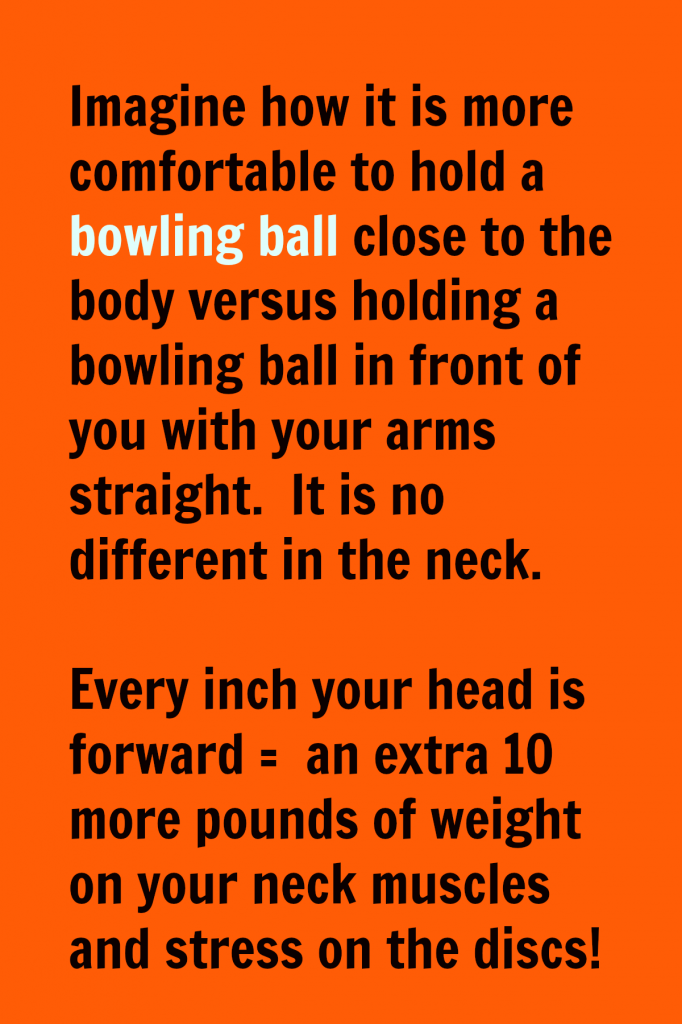Why You Should Care About Neck Posture
 Posture is so much more important than how it relates to our appearance. It goes beyond how well we look and actually affects how well we ARE! May is National Posture month. I thought I would take the opportunity to discuss posture in this three-part blog series covering the neck (cervical) area, the middle back (thoracic) area and finally the lower back (lumbar) area.
Posture is so much more important than how it relates to our appearance. It goes beyond how well we look and actually affects how well we ARE! May is National Posture month. I thought I would take the opportunity to discuss posture in this three-part blog series covering the neck (cervical) area, the middle back (thoracic) area and finally the lower back (lumbar) area.
Why We Slouch
Many things affect posture in a negative way – from sitting at a computer all day to just the simple fact that we are constantly looking forward and down with most everything we do. It takes effort to counteract the things that tend to train our body to have a more forward, slouched posture. There is no way to easily counteract all of those repetitive, stressful postures with a simple hour work out at the gym! Good, strong posture involves developing your postural muscles so they naturally hold you where you need to be.
Biggest Neck Posture Issue
 Head-forward posture is by far one of the most common postural abnormalities I see in the office. This occurs when we lose the normal lordosis, or curve in the cervical spine. From the side, there should be a C curve in the neck with the neck curving forward toward the front of the body and then back, bringing the head on top of the shoulders. This actually creates a bit of springiness to lessen the stress of holding the weight of the head (8-16 pounds). The hole in your ear should line up near the shoulder seam of your shirt. When the curve is lost in the neck, the neck angles forward as it comes off the upper back and fails to come back again in the C shape. This causes a head forward posture. The more forward the head, the more stress on the muscles and ligaments supporting the head.
Head-forward posture is by far one of the most common postural abnormalities I see in the office. This occurs when we lose the normal lordosis, or curve in the cervical spine. From the side, there should be a C curve in the neck with the neck curving forward toward the front of the body and then back, bringing the head on top of the shoulders. This actually creates a bit of springiness to lessen the stress of holding the weight of the head (8-16 pounds). The hole in your ear should line up near the shoulder seam of your shirt. When the curve is lost in the neck, the neck angles forward as it comes off the upper back and fails to come back again in the C shape. This causes a head forward posture. The more forward the head, the more stress on the muscles and ligaments supporting the head.
What Causes Head-Forward Posture
There are many causes, including poor ergonomics, heavy backpacks, video games, smart devices, old whiplash injuries, using poor pillows for sleep and other repetitive types of postures that involve looking forward or down. Head-forward posture can cause tension headaches, TMJ and poor breathing.
Tips for Improving Head-Forward Posture
- The top third of your computer screen should line up with your eyes and be angled so that the top is 10 degrees backward.
- Take micro breaks at work to stretch the neck and do a few strengthening exercises.
- Use a low back support. This causes you to bring the upper back and neck back into the right position.
- Do not carry more than 15 percent of your body weight in your back pack. Always use both straps.
- Take up a yoga class. Yoga practice automatically strengthens postural muscles.
- Consider buying a posture pump (this website has a great video to show you how it works). By laying on the pump daily, you create a mild traction to retrain your muscles and ligaments to assume a more normal curve.
I love this chiropractor’s video. She explains it perfectly and has other posture videos, as well.
Let’s all stand a little taller, breath a little deeper and develop not just good posture, but strong posture.



Write a Comment